

EMI Cassette Tapes
#19. The Beatles At The Hollywood Bowl (TC-EMTV 4)
(Update: 14th. March 2024)




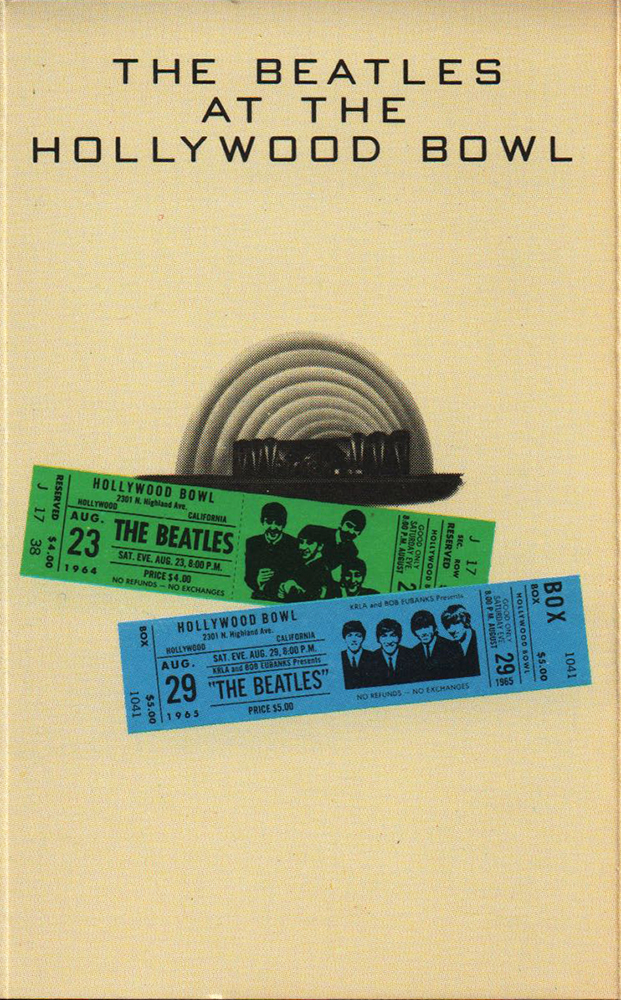 |
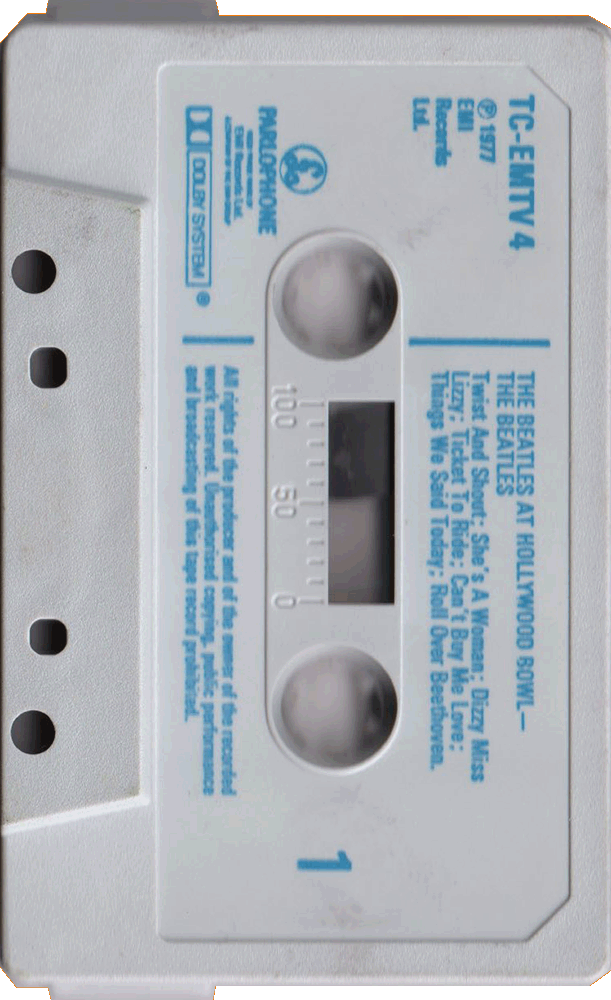 |
|
|
| Original Inlay
and Tape |
|||
|
TITLE
|
THE BEATLES AT
THE HOLLYWOOD BOWL |
|||
| CATALOG NUMBER | TC-EMTV 4 / 0C 262 o 06377 |
|||
|
RELEASE DATE
|
May 1977 / First Issue | |||
| TRACK LISTING | SIDE 1 |
SIDE 2 |
||
| Twist And Shout |
Boys |
|||
| She's A Woman |
A Hard Day's Night |
|||
| Dizzy Miss Lizzy |
Help |
|||
| Ticket To Ride |
All My Loving |
|||
| Can't Buy Me Love |
She Loves You |
|||
| Things We Said Today |
Long Tall Sally | |||
| Roll Over Beethoven | ||||
| CASSETTE CASE AND TAPE |
CASE FRONT | CASE BACK | SIDE 1 --> Click! | SIDE 2 --> Click! |
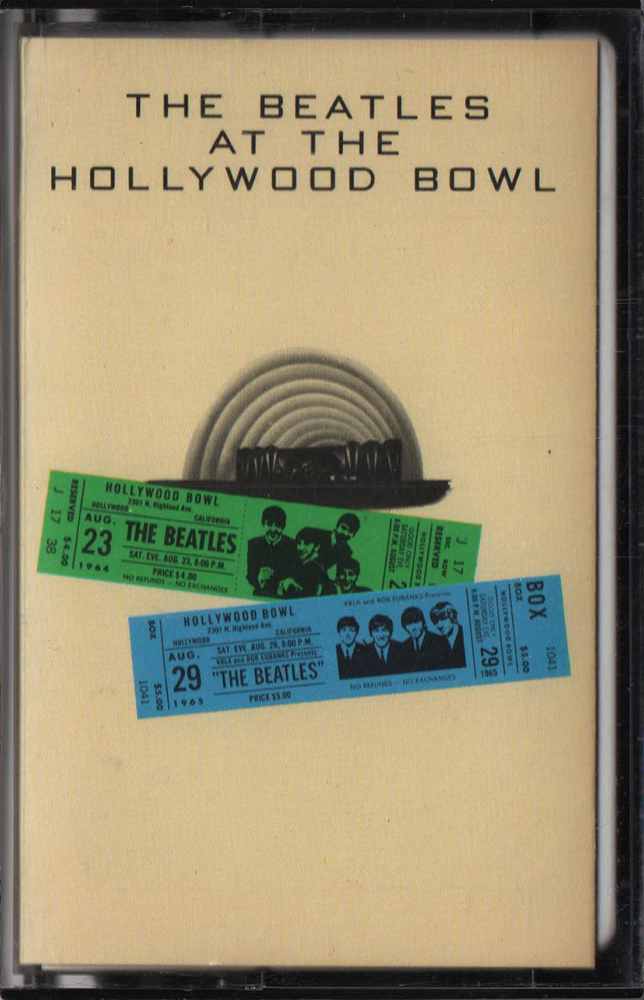 |
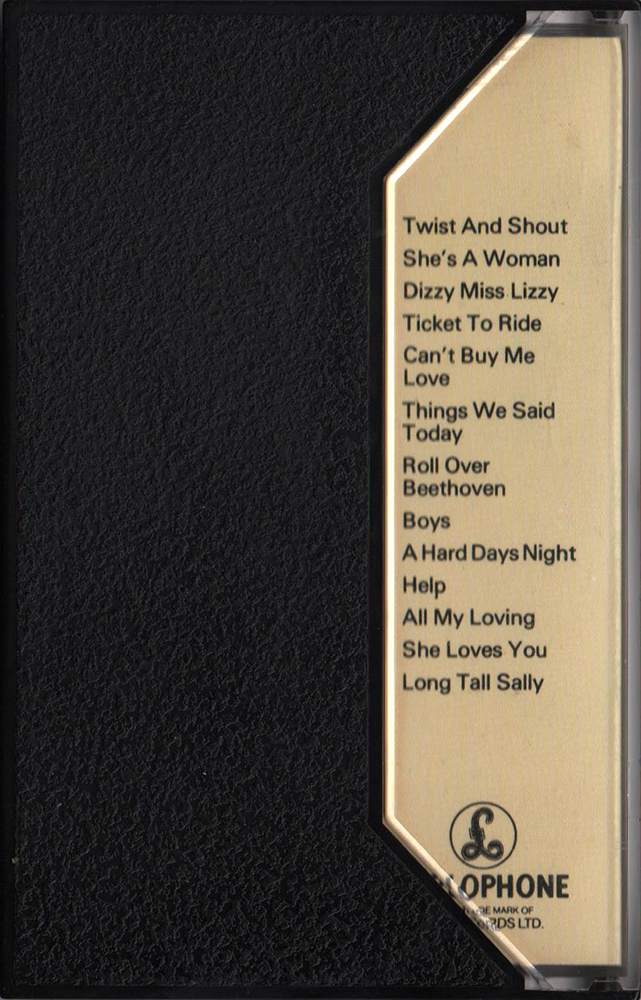 |
 |
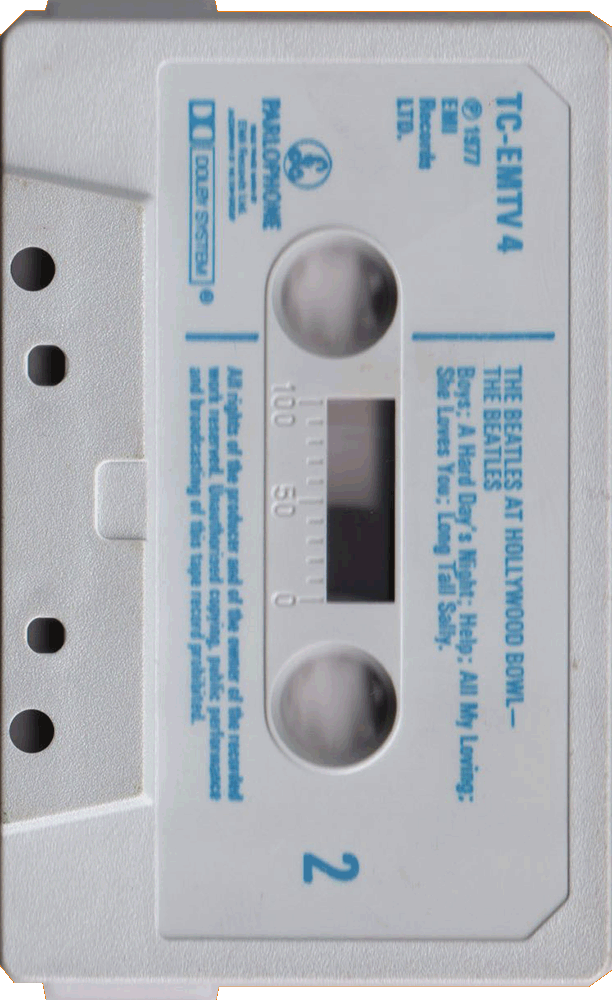 |
|
| The cassette cases ("Norelco" cases)
were clear plastic at the front and around the spine area,
and black plastic at the rear. |
The first UK issue has direct print in blue ink
on the shell with Parlophone logo |
|||
| INLAY |
INLAY: FRONT | INLAY: INSIDE |
||
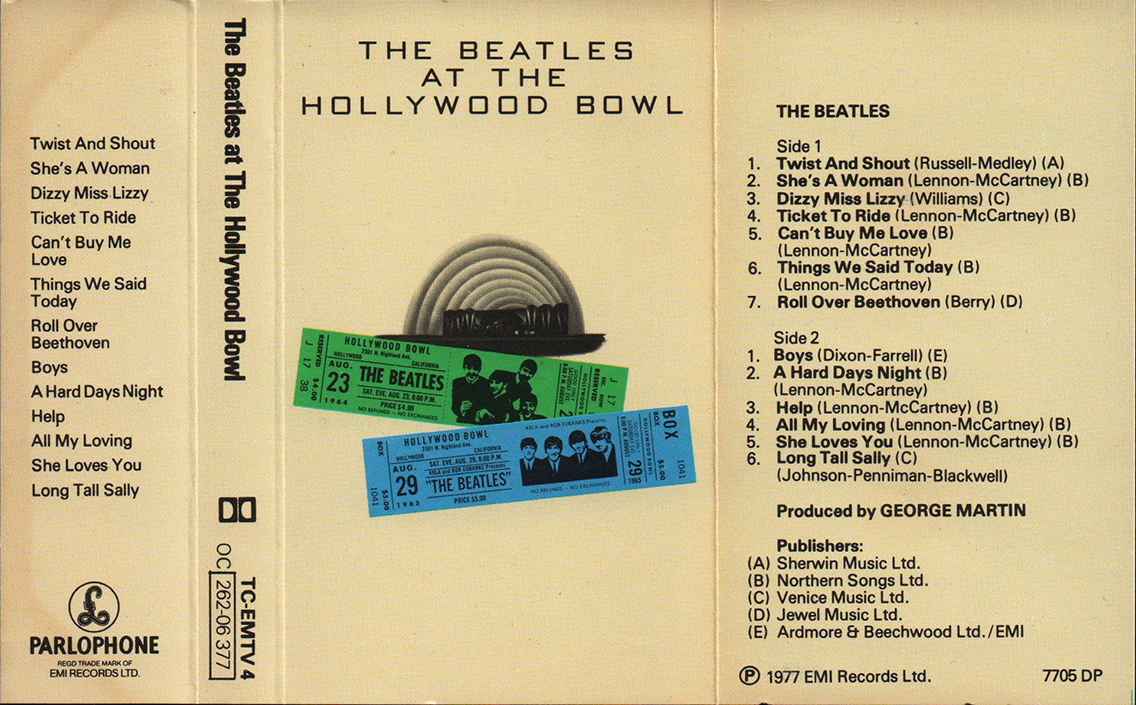 |
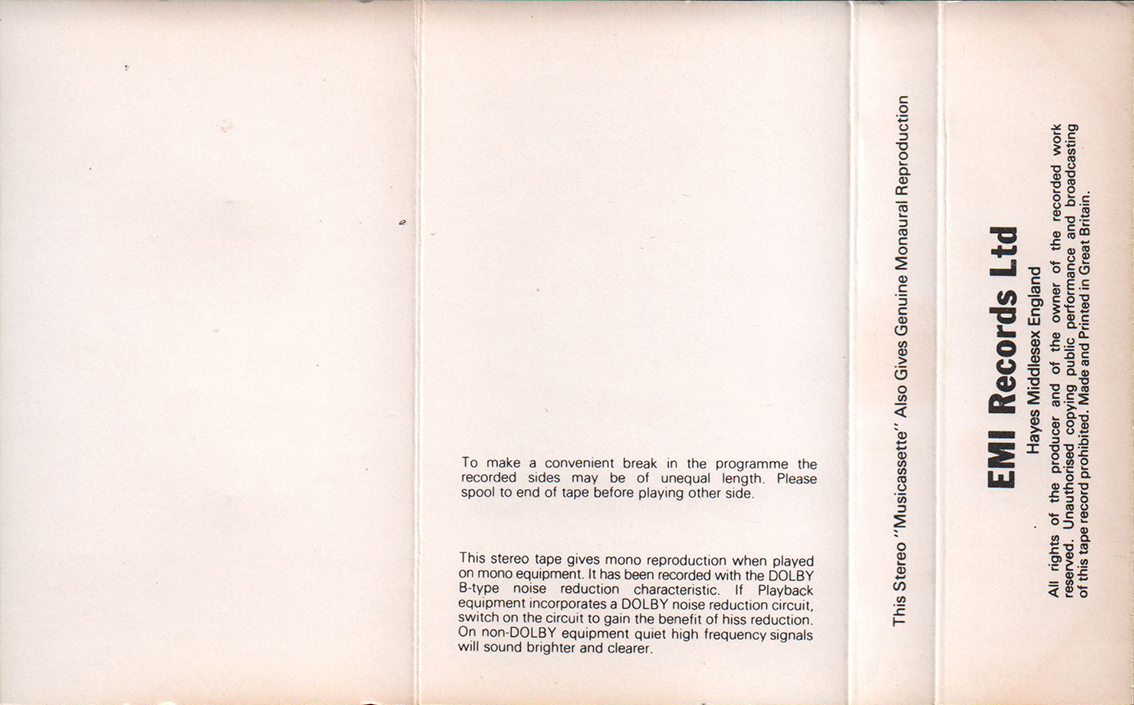 |
|||
| Custom inlay. With Parlophone logo. |
||||
| INLAY: FRONT CLOSE UP | ||||
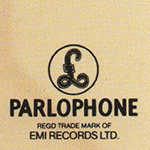 |
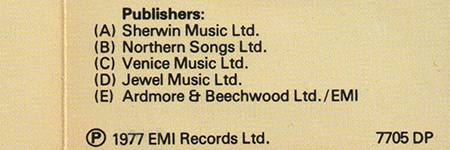 |
The Parlophone logomark
was printed on the inlay. Publisher's names were printed on the inlay. |
||
| INLAY: FRONT CLOSE UP | ||||
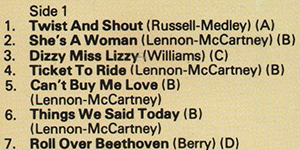 |
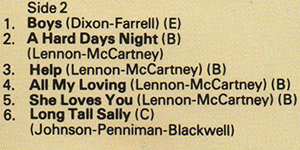 |
The cassette of the album "At The Hollywood Bowl' is recorded in the same order as the LP. | ||
| INLAY: FRONT CLOSE UP | ||||
 |
Catalog number "TC-EMTV 4" and the EMI country code (*1) and DOLBY logo were printed on the inlay. |  |
Printer company's name and relrease date "7705 DP (**)" was printed at the bottom of the inlay. | |
| INLAY: FRONT & INSIDE CLOSE UP | ||||
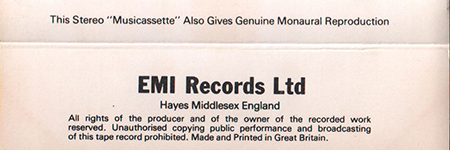 |
"EMI Records
Ltd Hayes Middlesex England" credit and "Made and
Printed in Great Britain" were printed at the bottom of the
inside of the inlay. |
|||
| LABEL CLOSE UP | ||||
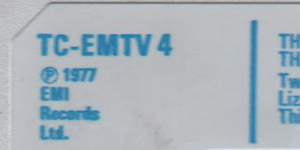 |
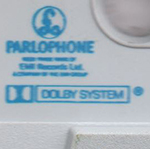 |
"TC-EMTV 4" catalogue
number and Parlophone logo were printed. NO mark was moulded into cassette shells. |
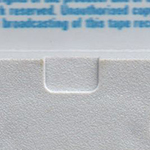 |
|
| LABEL CLOSE UP | ||||
| SIDE 1 | SIDE 2 | The cassette of
the album "At The Hollywood Bowl' is recorded in the same
order as the LP. |
||
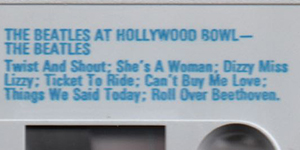 |
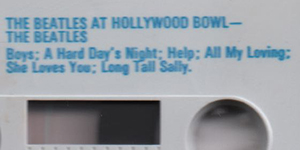 |
|||
| LABEL CLOSE UP | ||||
 |
"Made
in England/Made in U.S.A" was not embossed on the
shell. |
|||
| OTHER ITEM | ||||
| - |
||||
| LABEL | Direct print in blue ink on the shell with
Parlophone logo |
|||
| MIX | STEREO / DOLBY B-type |
|||
| RECORD COMPANY'S NAME | EMI Records Ltd |
|||
| CENTRAL REMARK "SOLD IN U.K." |
- | |||
| RECORDING PUBLISHED CREDIT | (P) 1977 |
|||
| INLAY FORM | Custom inlay (Foldover) |
|||
| SHELL | Light Grey Shell |
|||
| CASSETTE CASE |
"Norelco"
cases: clear plastic at the front and around the spine area,
and black plastic at the rear. |
|||
| PRINTER CREDIT | Made and Printed in Great Britain / 7705
DP |
|||
| COVER DESIGN/ PHOTO/ NOTES | - |
|||
| PRODUCER | George Martin | |||
| COMMENTS | Direct print in blue ink label
with Parlophone logo cassette. It has a grey tape shell with blue on-body text which suggests a manufacturing date of 1976 onwards. The "DP" notation on the inlay indicates the printer's initials (Ernest J Day, Garrod & Lofthouse, or Data Packaging(**)). The EMI UK catalog no. (TC-EMTV 4) was on the spine. The cassette cases ("Norelco" cases) were clear plastic at the front and around the spine area, and black plastic at the rear. Album (LP) was released May 6, 1977 in U.K. From the summer of 1976 E.M.I. embarked on a new series of T.V. advertised albums, the first of these was EMTV 1 - The Beach Boys "20 Golden Greats" which stayed at the top slot for 10 weeks. Glen Campbell was EMTV 2, The Shadows were the third, and The Beatles became the 4th ... hence the unusual catalogue number. EMTV 5 was The Supremes, EMTV 6 was Cliff Richard, EMTV 7 was The Black and White Minstrels, EMTV 8 was Buddy Holly, EMTV 9 was Nat 'King' Cole, and EMTV 10 was Frank Sinatra. All of the above were heavily (and expensively) promoted on nationwide T.V. and all had immense chart success, eight of the ten reaching number one. E.M.I. budgeted £200,000 of advertising on the Beatles release and this was one of the eight chart-toppers. The Beatles' only official live album was recorded over three nights at the Hollywood Bowl in Los Angeles, in 1964 and 1965. During their first full American tour Capitol agreed to record the group's concert at the Hollywood Bowl on 23 August 1964. The Beatles performed 12 songs at the concert: Twist And Shout, You Can't Do That, All My Loving, She Loves You, Things We Said Today, Roll Over Beethoven, Can't Buy Me Love, If I Fell, I Want To Hold Your Hand, Boys, A Hard Day's Night and Long Tall Sally. George Martin was initially reluctant to tape the concert, and after mixing the tracks on 27 August Capitol decided the quality of the recording was not suitable for release. They did, however, include a 48-second extract from Twist And Shout on the 1964 documentary album The Beatles' Story. The Beatles returned to the Hollywood Bowl the following year, playing two further sell-out concerts on 29 and 30 August 1965. Capitol Records again recorded the two shows. They played the same set on both nights: a truncated version of Twist And Shout, followed by She's A Woman, I Feel Fine, Dizzy Miss Lizzy, Ticket To Ride, Everybody's Trying To Be My Baby, Can't Buy Me Love, Baby's In Black, I Wanna Be Your Man, A Hard Day's Night, Help! and I'm Down. Although they had hoped the 1965 recordings would be better than the previous year's, Capitol decided that the quality was insufficient for release. The tapes remained in the record company vaults for several years, and in 1971 were given to Phil Spector to see if an album could be prepared. However, Spector's work came to nothing, and the tapes remained unreleased for several more years. In the mid-1970s Capitol president Bhaskar Menon gave George Martin the tapes and asked him to compile an official live album. Although impressed with The Beatles' performances, he found the sound quality disappointing. Nonetheless, in January 1977 he began working with studio engineer Geoff Emerick to clean up the master tapes and assemble a set of songs for release. Six songs were included from the 23 August 1964 concert tapes: Things We Said Today, Roll Over Beethoven, Boys, All My Loving, She Loves You and Long Tall Sally. Due to an error, the tracklisting for The Beatles At The Hollywood Bowl lists all the recordings as dating from 1964 or 30 August 1965. However, three of the songs - Ticket To Ride, Dizzy Miss Lizzy and Help! - originated from 29 August 1965. Unfortunately a technical fault left Paul McCartney's vocals and introductions inaudible during the first four songs of the first 1965 show, rendering a substantial portion of the recordings unusable. Five songs from 30 August 1965 appeared on The Beatles At The Hollywood Bowl: Twist And Shout, She's A Woman, Dizzy Miss Lizzy, Can't Buy Me Love and A Hard Day's Night. The album version of Dizzy Miss Lizzy was a composite edit incorporating parts of the 29 and 30 August performances. (from the "Beatles Bible") EMI originally issued the Beatles UK albums on cassette tape with re-arranged running orders, the excuse being the need to have two sides of equal length to avoid the problem of listeners stopping the tape at the end of one side and turning over to start mid-way through the opening track on the reverse. (*1) EMI country code: 0C 244 o 04002 The EMI country codes (introduced on 1 June, 1969): In most cases the EMI Codes are the first two letters of the record's catalog#. These EMI Country Codes were used to indicate the country in which the record was pressed. Note this doesn't necessarily means the record was also released in that country (from Discog). OC / 0C / 1E= UK (**) Data Packaging Corporation: (who also traded as Hellerman Data Packaging Ltd) supplied cassette and 8 track shells, tape and other components to the music industry. The "DP" logo can often be found moulded into cassette shells, especially during the early to mid 1970s. DOLBY B-type: A Dolby noise-reduction system, or Dolby NR, is one of a series of noise reduction systems developed by Dolby Laboratories for use in analog audio tape recording. The first was Dolby A, a professional broadband noise reduction system for recording studios in 1965, but the best-known is Dolby B (introduced in 1968) for the consumer market, which helped make high fidelity practical on cassette tapes, which used a relatively noisy tape size and speed. From the mid-1970s, Dolby B became standard on commercially pre-recorded music cassettes. |
|||